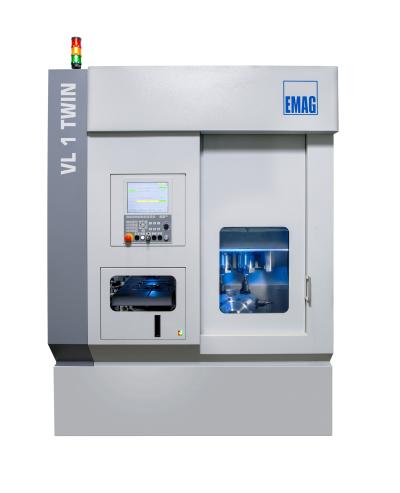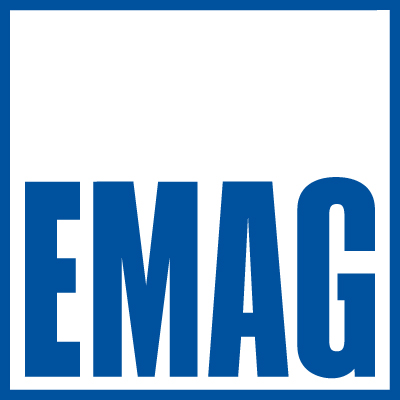
The challenges in the automotive industry are growing—and fast. Take transmissions for instance: Existing systems such as automatic torque converters and dual-clutch transmissions are constantly being enhanced. These are being supplemented by unique hybrid drives and assistance systems, which increase the complexity of the overall system. In this context, the main goal of quality managers is “zero fault tolerance,” now more than ever. Each component must flawless when they leave the production area - and at the lowest possible unit costs. With its new VL 1 TWIN, EMAG shows how a highly specialized machinery manufacturer is able to master the challenge.
The twin-spindle pick-up turning center for components up to 75 millimeters (3 inches) in diameter simultaneously machines two identical components in a single machining area. At the same time, equipment such as the linear motor and the direct distance measuring system in the X-axis provide precision and long-term accuracy. This makes the production of essential transmission components, such as planetary and sun gears, significantly more efficient. It also improves the manufacturing of cam parts, flanges, sleeves and roller bearing rings at every level.
“Quantity and quality” are shaping transmission manufacturing more than ever: Considering the increasing number of gears in transmissions, the quantity of gears and other toothed components produced is undeniably on the rise. At the same time, the quality of the components must also increase to achieve the power density required in modern transmissions. The performance features expected of transmissions, such as a long service life with optimal dynamic response, also still apply. Is it at all possible to reconcile growing quality and productivity requirements with generally increasing pressure on costs?
“That was precisely our goal,” says Peter Loeztner, president and CEO at EMAG LLC. “We have developed a low-cost machine, that enables high output volumes with short lead times due to its two pick-up spindles and also ensures dynamics as well as repeatability and long-term accuracy with its direct distance measuring systems in the X-axis, size 45 recirculating roller guide rails, and innovative linear motor. It is the perfect solution for turned parts with diameters of up to 75 millimeters (3 inches).”
The possibilities made possible by this approach become clear from a simple description of the production sequence: A simultaneous process (OP10/OP10) is performed on two identical workpieces, quickly, within the machine. Both components are picked up from the conveyor belt by the two pick-up spindles (9.9 kW/136 Nm at 40 percent duty cycle), transported to the machining area, and machined in a single clamping operation—the diameter and length (X/Z directions) of the two components can be adjusted independently, because the movement of the spindles is entirely autonomous. The linear motor in the X-axis combined with the direct distance measuring system also increase the speed in the simultaneous sequence. What cycle times are possible with these features? “It obviously depends on the component and process,” says Loetzner. “Generally, the average chip-to-chip time is just under five seconds.
EMAG uses the productive twin approach for advanced manufacturing solutions. For example with the VL 1 TWIN Line: two VL 1 TWIN machines are linked together using the TrackMotion automation system. Machining is then performed simultaneously on two sides of two components in OP10 and OP20. This allows for cycle times of less than 20 seconds to be achieved for the entire OP10/OP10 and OP20/OP20 sequence—an incredibly low figure, ensuring significantly lower unit costs for the soft machining of planetary gears. The system is also equipped with an extensive parts storage area for raw and finished parts. The use of space optimized stacker pallets allows for a large number of components to be accommodated in a very small space. Doing so, by stacking the parts as the name already implies. With the TrackMotion automation system linking machines, EMAG is able to deliver multiple-technology production lines. Let’s take gearwheels as an example: After machining two sides of the blank using two VL 1 TWINs, an EMAG hobbing machine cuts the gear teeth on the component. Finally, deburring is performed with EMAG technology in OP40. The TrackMotion automation system allows for a fast pace between operations with a maximum travel speed of 150 m/min (5,905 in/min).
A goal during the development of the VL 1 TWIN was to achieve consistent, high quality workpieces, as evident by various configuration details. For instance, there is a direct and extremely precise distance measuring system in the X-axis, the recirculating roller guides ensure high rigidity, as well as guidance precision, and the MINERALIT polymer concrete machine base reduces vibrations during the turning process. An optional measuring system between the machining area and the pick-up stations continue to increase the process reliability.
“Extreme precision and long-term accuracy are always an integral part of this machine,” says Loetzner.
However, the fact that these high requirements are achieved with low investment costs for the user may be the most surprising highlight of this technology. EMAG is committed to rigorous cost control during the entire development process and also uses standardized high-performance components. This is how the price per spindle was significantly reduced. The basic machine (without chip conveyor and automation system) has a footprint of only 4.59 square meters (50 square feet)—and this will naturally cuts costs even further when establishing a new production process.
“With this turning center, we really bring all the decisive factors together,” concludes Loetzner. “The VL 1 TWIN ensures extremely low cycle times, guarantees high component quality, and minimizes investment costs. Additionally, we’re able to configure highly flexible system solutions for both sub-processes and complete processes. At the end of the day, our customers benefit from significantly lower unit costs.”
Contact Details
Related Glossary Terms
- computer-aided manufacturing ( CAM)
computer-aided manufacturing ( CAM)
Use of computers to control machining and manufacturing processes.
- linear motor
linear motor
Functionally the same as a rotary motor in a machine tool, a linear motor can be thought of as a standard permanent-magnet, rotary-style motor slit axially to the center and then peeled back and laid flat. The major advantage of using a linear motor to drive the axis motion is that it eliminates the inefficiency and mechanical variance caused by the ballscrew assembly system used in most CNC machines.
- shaping
shaping
Using a shaper primarily to produce flat surfaces in horizontal, vertical or angular planes. It can also include the machining of curved surfaces, helixes, serrations and special work involving odd and irregular shapes. Often used for prototype or short-run manufacturing to eliminate the need for expensive special tooling or processes.
- tolerance
tolerance
Minimum and maximum amount a workpiece dimension is allowed to vary from a set standard and still be acceptable.
- turning
turning
Workpiece is held in a chuck, mounted on a face plate or secured between centers and rotated while a cutting tool, normally a single-point tool, is fed into it along its periphery or across its end or face. Takes the form of straight turning (cutting along the periphery of the workpiece); taper turning (creating a taper); step turning (turning different-size diameters on the same work); chamfering (beveling an edge or shoulder); facing (cutting on an end); turning threads (usually external but can be internal); roughing (high-volume metal removal); and finishing (final light cuts). Performed on lathes, turning centers, chucking machines, automatic screw machines and similar machines.

